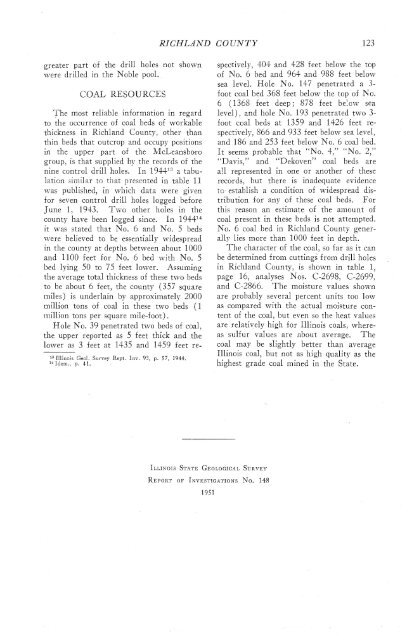subsurface geology and coal resources of the pennsylvanian system ...
subsurface geology and coal resources of the pennsylvanian system ...
subsurface geology and coal resources of the pennsylvanian system ...
Create successful ePaper yourself
Turn your PDF publications into a flip-book with our unique Google optimized e-Paper software.
RICHLAND COUNTY 123<br />
greater part <strong>of</strong> <strong>the</strong> drill holes not shown<br />
were drilled in <strong>the</strong> Noble pool.<br />
COAL RESOURCES<br />
The most reliable information in regard<br />
to <strong>the</strong> occurrence <strong>of</strong> <strong>coal</strong> beds <strong>of</strong> workable<br />
thickness in Richl<strong>and</strong> County, o<strong>the</strong>r than<br />
thin beds that outcrop <strong>and</strong> occupy positions<br />
in <strong>the</strong> upper part <strong>of</strong> <strong>the</strong> IUcEeansboro<br />
group, is that supplied by <strong>the</strong> records <strong>of</strong> <strong>the</strong><br />
nine control drill holes. In 19W3 a tabulaticn<br />
similar tr; that presented in table 11<br />
was published, in which data were given<br />
for seven control drill holes logged before<br />
June 1, 191-3. Two o<strong>the</strong>r holes in <strong>the</strong><br />
county have been logged since. In 194414<br />
it was stated that No. 6 <strong>and</strong> No. 5 beds<br />
were believed to be essentially widespread<br />
in <strong>the</strong> county at depths between about 1000<br />
<strong>and</strong> 1100 feet for No. 6 bed with No. 5<br />
bed lying 50 to 75 ieet lower. Assuming<br />
<strong>the</strong> average total thickness <strong>of</strong> <strong>the</strong>se two beds<br />
to be about 6 feet, <strong>the</strong> county (357 square<br />
miles) is underlain by approximately 2000<br />
million tons <strong>of</strong> <strong>coal</strong> in <strong>the</strong>se two beds (1<br />
million tons per square mile-foot) .<br />
Hole No. 39 penetrated two beds <strong>of</strong> <strong>coal</strong>,<br />
<strong>the</strong> upper reported as 5 feet thick <strong>and</strong> <strong>the</strong><br />
lower as 3 feet at 1435 <strong>and</strong> 1459 feet re-<br />
l3 Illinois Geol. Survey Rept. Inv. 93, p. 57, 1944.<br />
Idem., p. 41.<br />
spectively, 404 <strong>and</strong> 428 feet below <strong>the</strong> top<br />
<strong>of</strong> No. 6 bed <strong>and</strong> 964 <strong>and</strong> 988 feet below<br />
sea level. Hole No. 147 penetrated a 3-<br />
foot <strong>coal</strong> bed 368 feet below <strong>the</strong> top <strong>of</strong> No.<br />
6 (1368 feet deep; 878 feet below sea<br />
level), <strong>and</strong> hole No. 193 penetrated two 3-<br />
foot <strong>coal</strong> beds at 1359 <strong>and</strong> 1426 feet respectively,<br />
865 <strong>and</strong> 933 feet below sea level,<br />
<strong>and</strong> 186 <strong>and</strong> 253 feet below No. 6 <strong>coal</strong> bed.<br />
It seems probable that "No. 4," "No. 2,"<br />
"Davis," <strong>and</strong> "Dekoven" <strong>coal</strong> beds are<br />
all represented in one or ano<strong>the</strong>r <strong>of</strong> <strong>the</strong>se<br />
records, but <strong>the</strong>re is inadequate evidence<br />
to establish a condition <strong>of</strong> widespread distribution<br />
for any <strong>of</strong> <strong>the</strong>se <strong>coal</strong> beds. For<br />
this reason an estimate <strong>of</strong> <strong>the</strong> amount <strong>of</strong><br />
<strong>coal</strong> present in <strong>the</strong>se beds is not attempted.<br />
No. 6 <strong>coal</strong> bed in Richl<strong>and</strong> County generally<br />
lies more than 1000 feet in depth.<br />
The character <strong>of</strong> <strong>the</strong> <strong>coal</strong>, so far as ~t ' can<br />
be determined from cuttings from drill holes<br />
in Richl<strong>and</strong> County, is shown in table 1,<br />
page 16, analyses Nos. 6-2698, C-2599,<br />
<strong>and</strong> C-2866. The moisture values shown<br />
are probably several percent units too low<br />
as compared with <strong>the</strong> actual moisture content<br />
<strong>of</strong> <strong>the</strong> <strong>coal</strong>, but even sa <strong>the</strong> heat values<br />
are relatively high for Illinois <strong>coal</strong>s, whereas<br />
sulfur values are about average. The<br />
caal may be slightly better than average<br />
Illinois <strong>coal</strong>, but not as high quality as <strong>the</strong><br />
highest grade <strong>coal</strong> mined in <strong>the</strong> State.
















